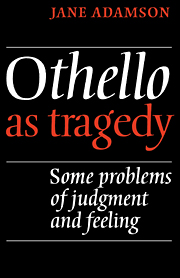Book contents
- Frontmatter
- Contents
- Preface
- Introduction
- 1 The ‘comforts’ of praise and blame
- 2 ‘Injuries’ and ‘remedies’: the first two acts
- 3 ‘Pluming up the will’: Iago's place in the play
- 4 Personal and professional identity: Othello in the first two acts
- 5 ‘Alacrity in hardness’: Othello's crisis in Acts III and IV
- 6 The ‘hollow hell’ of vengeance: Othello's attempted remedies
- 7 Self-charity and self-abnegation: the play's women in love
- 8 The ‘power to hurt’ and ‘be hurt’, ‘past all surgery’: the final scene
3 - ‘Pluming up the will’: Iago's place in the play
Published online by Cambridge University Press: 16 September 2009
- Frontmatter
- Contents
- Preface
- Introduction
- 1 The ‘comforts’ of praise and blame
- 2 ‘Injuries’ and ‘remedies’: the first two acts
- 3 ‘Pluming up the will’: Iago's place in the play
- 4 Personal and professional identity: Othello in the first two acts
- 5 ‘Alacrity in hardness’: Othello's crisis in Acts III and IV
- 6 The ‘hollow hell’ of vengeance: Othello's attempted remedies
- 7 Self-charity and self-abnegation: the play's women in love
- 8 The ‘power to hurt’ and ‘be hurt’, ‘past all surgery’: the final scene
Summary
let me see now;
To get his place and to plume up my will
In double knavery. How? How? Let's see.
(i, iii, 386–8)So many critics over the years have made so much sense (not to mention nonsense) of Iago that one naturally hesitates to dig over the plot again. Yet much of the debate about his ‘character’ and about his ‘symbolic’ status has tended less to clarify than to obscure his place in the dramatic design, and it still seems worth insisting on what by now ought to be a commonplace – that Iago's intrigue and what prompts him to undertake and persist in it, are imagined and judged in the same terms as apply to everyone else in the play. His speeches and actions continually illuminate and are themselves illuminated by those of all the other characters. As Bradley rightly pointed out, Iago is not arbitrarily introduced into the play to represent inexplicable evil or Evil. Certainly, his behaviour cannot be accounted for by any or all of his own declared motives for it, nor did Shakespeare see fit to explain how Iago came to be as he is; but – and it is a ‘but’ whose force we cannot afford to ignore – the way Iago thinks and speaks is dramatically conceived and dramatically ‘placed’ in relation to everything else in Othello.
- Type
- Chapter
- Information
- Othello As TragedySome Problems of Judgement and Feeling, pp. 64 - 106Publisher: Cambridge University PressPrint publication year: 1980



